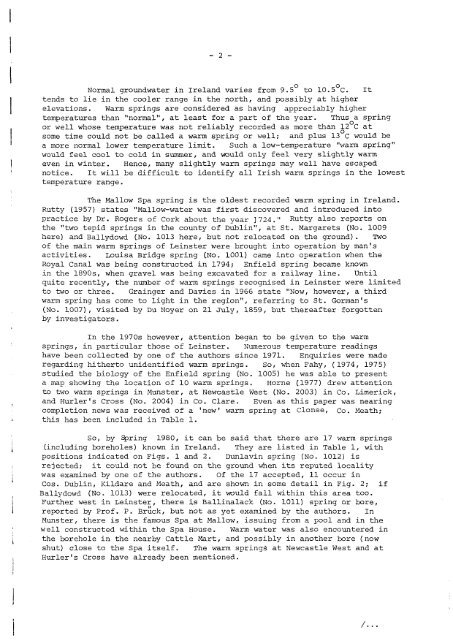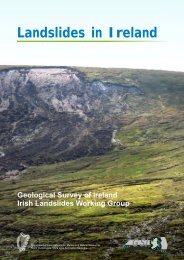Hydrogeothermal Conditions in Ãire - Geological Survey of Ireland
Hydrogeothermal Conditions in Ãire - Geological Survey of Ireland
Hydrogeothermal Conditions in Ãire - Geological Survey of Ireland
Create successful ePaper yourself
Turn your PDF publications into a flip-book with our unique Google optimized e-Paper software.
- 2 -Normal groundwater <strong>in</strong> <strong>Ireland</strong> varies from 9.5 0 to 10.5 0 C. Ittends to lie <strong>in</strong> the cooler range <strong>in</strong> the north, and possibly at higherelevations. Warm spr<strong>in</strong>gs are considered as hav<strong>in</strong>g appreciably highertemperatures than "normal", at least for a part <strong>of</strong> the year. Thus a spr<strong>in</strong>gor well whose temperature was not reliably recorded as more than 12 0 C atsome time could not be called a warm spr<strong>in</strong>g or well; and plus 13 0 C would bea more normal lower temperature limit. Such a low-temperature "warm spr<strong>in</strong>g"would feel cool to cold <strong>in</strong> summer, and would only feel very slightly warmeven <strong>in</strong> w<strong>in</strong>ter. Hence, nmny slightly warm spr<strong>in</strong>gs may well have escapednotice. It will be difficult to identify all Irish warm spr<strong>in</strong>gs <strong>in</strong> the lowesttemperature range.The Mallow Spa spr<strong>in</strong>g is the oldest recorded warm spr<strong>in</strong>g <strong>in</strong> <strong>Ireland</strong>.Rutty (1957) states "Mallow-water was first discovered and <strong>in</strong>troduced <strong>in</strong>topractice by Dr. Rogers <strong>of</strong> Cork about the year J724." Rutty also reports onthe "two tepid spr<strong>in</strong>gs <strong>in</strong> the county <strong>of</strong> Dubl<strong>in</strong>", at St. Margarets (No. 1009here) and Ballydowd (No. 1013 here, but not relocated on the ground). Two<strong>of</strong> the ma<strong>in</strong> warm spr<strong>in</strong>gs <strong>of</strong> Le<strong>in</strong>ster were brought <strong>in</strong>to operation by man'sactivities. Louisa Bridge spr<strong>in</strong>g (No. 1001) came <strong>in</strong>to operation when theRoyal Canal was be<strong>in</strong>g constructed <strong>in</strong> 1794; Enfield spr<strong>in</strong>g became known<strong>in</strong> the 1890s, when gravel was be<strong>in</strong>g excavated for a railway l<strong>in</strong>e. Untilquite recently, the number <strong>of</strong> warm spr<strong>in</strong>gs recognised <strong>in</strong> Le<strong>in</strong>ster were limitedto two or three. Gra<strong>in</strong>ger and Davies <strong>in</strong> 1966 state "Now, however, a thirdwarm spr<strong>in</strong>g has come to light <strong>in</strong> the region", referr<strong>in</strong>g to st. Gorman's(No. 1007), visited by Du Noyer on 21 July, 1859, but thereafter forgottenby <strong>in</strong>vestigators.In the 1970s however, attention began to be given to the warmspr<strong>in</strong>gs, <strong>in</strong> particular those <strong>of</strong> Le<strong>in</strong>ster. Numerous temperature read<strong>in</strong>gshave been collected by one <strong>of</strong> the authors s<strong>in</strong>ce 1971. Enquiries were maderegard<strong>in</strong>g hitherto unidentified warm spr<strong>in</strong>gs. So, when Fahy, (1974, 1975)studied the biology <strong>of</strong> the Enfield spr<strong>in</strong>g (No. 1005) he was able to presenta map show<strong>in</strong>g the location <strong>of</strong> 10 warm spr<strong>in</strong>gs. Horne (1977) drew attentionto two warm spr<strong>in</strong>gs <strong>in</strong> Munster, at Newcastle West (No. 2003) <strong>in</strong> Co. Limerick,and Hurler's Cross (No. 2004) <strong>in</strong> Co. Clare. Even as this paper was near<strong>in</strong>gcompletion news was received <strong>of</strong> a 'new' warm spr<strong>in</strong>g at Clonee, Co. Meath;this has been <strong>in</strong>cluded <strong>in</strong> Table 1.So, by Spr<strong>in</strong>g 1980, it can be said that there are 17 warm spr<strong>in</strong>gs(<strong>in</strong>clud<strong>in</strong>g boreholes) known <strong>in</strong> <strong>Ireland</strong>. They are listed <strong>in</strong> Table 1, withpositions <strong>in</strong>dicated on Figs. 1 and 2. Dunlav<strong>in</strong> spr<strong>in</strong>g (No. 1012) isrejected; it could not be found on the ground when its reputed localitywas exam<strong>in</strong>ed by one <strong>of</strong> the authors. Of the 17 accepted, 11 occur <strong>in</strong>Cos. Dubl<strong>in</strong>, Kildare and Meath, and are shown <strong>in</strong> some detail <strong>in</strong> Fig. 2; ifBallydowd (No. 1013) were relocated, it would fall with<strong>in</strong> this area too.Further west <strong>in</strong> Le<strong>in</strong>ster, there is Ball<strong>in</strong>alack (NO. 1011) spr<strong>in</strong>g or bore,reported by Pr<strong>of</strong>. P. Br~ck, but not as yet exam<strong>in</strong>ed by the authors. InMunster, there is the famous Spa at Mallow, issu<strong>in</strong>g from a pool and <strong>in</strong> thewell constructed with<strong>in</strong> the Spa House. Warm water was also encountered <strong>in</strong>the borehole <strong>in</strong> the nearby Cattle Mart, and possibly <strong>in</strong> another bore (nowshut) close to the Spa itself. The warm spr<strong>in</strong>gs at Newcastle West and atHurler's Cross have already been mentioned./ ...
















